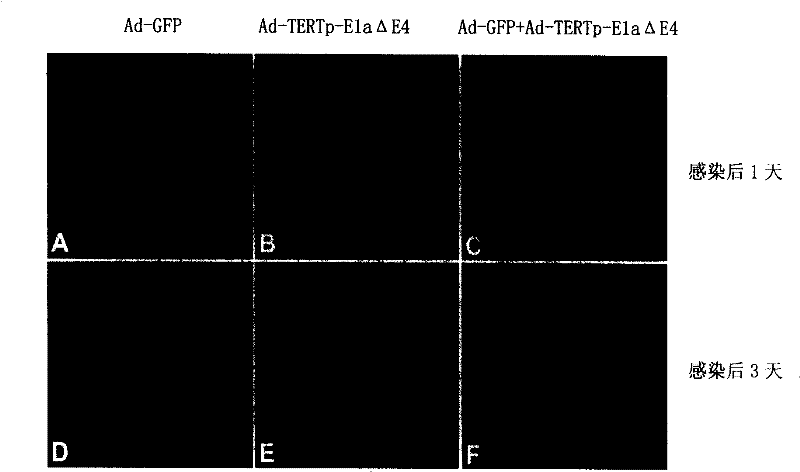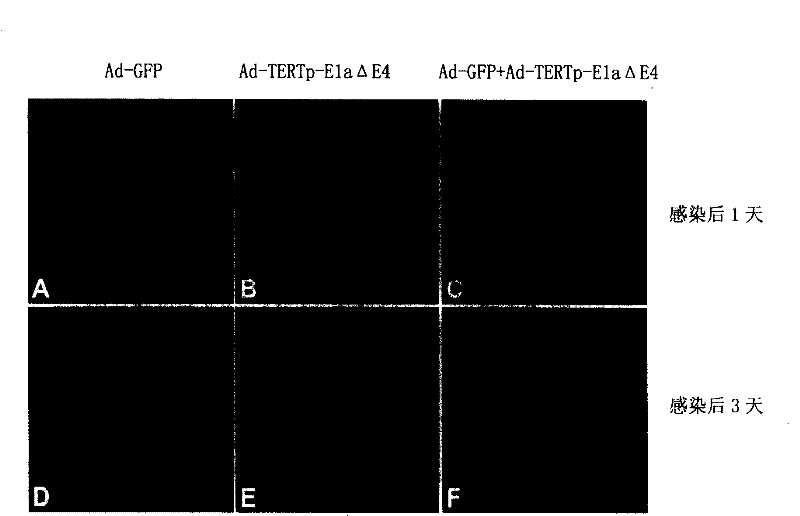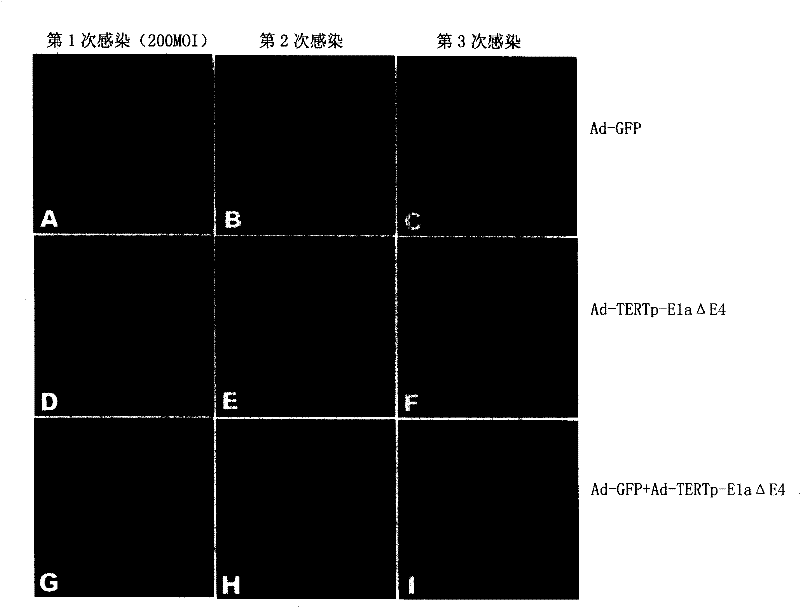Method for replicating adenovirus by way of selection and mutual compensation
A technology of adenovirus and virus, applied in the field of biomedicine, can solve problems such as the influence of human hematopoiesis, and achieve the effect of flexible and diverse treatment and high safety
- Summary
- Abstract
- Description
- Claims
- Application Information
AI Technical Summary
Problems solved by technology
Method used
Image
Examples
Embodiment 1
[0021] The tumor-specific TERT promoter and E1a gene were isolated by molecular cloning technology.
[0022] The present invention uses PCR technology to amplify the TERT promoter and the E1a gene sequence respectively using human cervical cancer Hela cells and wild-type adenovirus Ad5DNA as templates, inserting them into the shuttle plasmid pAdtrack, and constructing a gene sequence controlled by the TERT promoter to express E1a. pAdtrack-TERTp-E1a plasmid.
[0023] Primer sequences for amplifying the TERT promoter:
[0024] Upstream primer 5'-CAATGATATCTTCCCAGGGCTCCACATCATG-3'
[0025] Downstream primer 5'-ATAGTTTAGCGGCCGCACGCAGCGCTGCCTGAAACTC-3'
[0026] Primer sequences for amplifying the E1a gene:
[0027] Upstream primer 5'-ACCGGGACTGAAAATGAGAC-3'
[0028] Downstream primer 5'-TTAAGCATAATCTGGAACATCATATGGATATGGCCTGGGGCGTTTAC-3'
Embodiment 2
[0030] A replication-defective virus Ad-TERTp-E1aΔE4 with deletion of E4 gene and expression of E1a gene controlled by TERT promoter was constructed.
[0031] The present invention utilizes the AdEasy adenovirus vector system to construct a replication-deficient adenovirus, and the implementation steps are as follows:
[0032] 1. The backbone plasmid pAdEasy-2 (without E4 gene) was electrotransformed into BJ5183 bacteria, screened on an antibiotic plate, the clone was picked out, amplified, the plasmid was extracted, the integrity of pAdEasy-2 was checked by enzyme digestion, and the correct clone was selected as BJ5183- Ad-2 bacteria were prepared as electrocompetent cells.
[0033] 2. The recombinant plasmid pAdtrack-TERT p-E1a was constructed by using the shuttle plasmid pAdtrack (carrying the green fluorescent protein gene), TERT promoter and E1a fragment.
[0034] 3. BJ5183-Ad-2 was electrotransformed with pAdtrack-TERTp-E1a, screened with antibiotic plates, clones were pi...
Embodiment 3
[0039] Infection and Replication of Selective Complementary Replication Adenovirus in Cultured Cells in Vitro (1)
[0040] Currently, the replication-deficient adenoviruses commonly used in gene therapy generally have E1 gene deletion and a therapeutic gene inserted at this site, and this virus carries the E4 gene. Taking the replication-defective adenovirus Ad-GFP with the green fluorescent protein GFP gene as an example, we used our constructed virus Ad-TERTp-E1aΔE4 to co-infect the cultured cells in vitro.
[0041] Inoculate human cervical cancer Hela cells and normal human embryonic lung fibroblasts MRC-5 into six-well cell culture plates, 5×10 per well 5 cells. The viruses were added into Hela and MRC-5 cells according to the following three groups: the group with Ad-TERTp-E1aΔE4 alone; the group with Ad-GFP alone; the group with double viruses Ad-TERTp-E1aΔE4 and Ad-GFP. The amount of added virus was calculated according to 10 MOI of each cell infection, and the amount...
PUM
 Login to View More
Login to View More Abstract
Description
Claims
Application Information
 Login to View More
Login to View More - R&D
- Intellectual Property
- Life Sciences
- Materials
- Tech Scout
- Unparalleled Data Quality
- Higher Quality Content
- 60% Fewer Hallucinations
Browse by: Latest US Patents, China's latest patents, Technical Efficacy Thesaurus, Application Domain, Technology Topic, Popular Technical Reports.
© 2025 PatSnap. All rights reserved.Legal|Privacy policy|Modern Slavery Act Transparency Statement|Sitemap|About US| Contact US: help@patsnap.com



